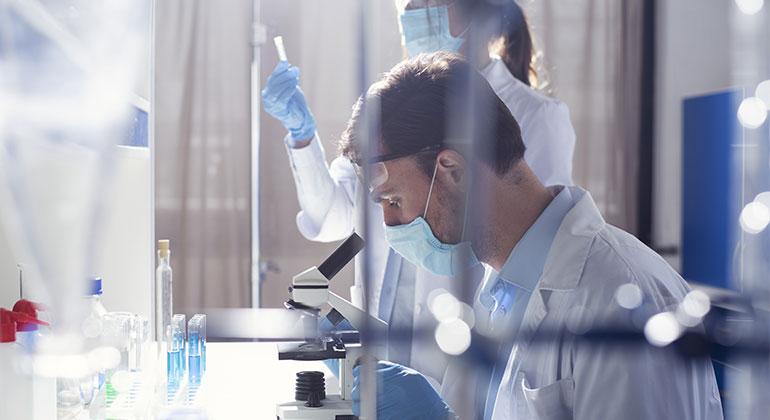World Trade Center Responders with the Greatest Exposure to Toxic Dust Have a Higher Likelihood of Liver Disease
Researchers linked the intensity of 9/11 dust exposure to liver injuries for the first time

Mount Sinai researchers have found evidence for the first time that World Trade Center responders had a higher likelihood of developing liver disease if they arrived at the site right after the attacks as opposed to working at Ground Zero later in the rescue and recovery efforts. Their study links the increase in liver disease risk to the quantity of toxic dust the workers were exposed to, which was greatest immediately after the September 11, 2001, attacks.
The study was published in the American Journal of Industrial Medicine in July.
The liver is often affected by chemical exposures due to its role in detoxifying foreign substances, and the liver disease whose early signs were detected in this study, hepatic steatosis, is associated with chemical exposures. Steatosis means that the liver contains abnormally high levels of fat.
In the aftermath of the 2001 attack, more than 20,000 responders were exposed to dust, airborne particulates, and chemicals known to cause liver toxicity, increasing their risk for toxicant-associated fatty liver disease, including the most serious form—toxicant-associated steatohepatitis—which can lead to liver failure and liver cancer. Mount Sinai monitors these responders as part of a federal World Trade Center Health Program under the direction of Michael Crane, MD.
“Our study showed that continued monitoring for liver disease is warranted in World Trade Center responders—such as law enforcement, fire, and recovery workers in any field at the site—particularly those who arrived at or shortly after the attacks and had a higher exposure to the toxic dust,” said the study’s senior author, Claudia Henschke, MD, PhD, Professor of Diagnostic, Molecular and Interventional Radiology at the Icahn School of Medicine at Mount Sinai. “At the moment, there are no protocols to monitor responders for liver disease, so this study points to the need to further study this issue in this at-risk population.”
Researchers discovered the liver disease by analyzing lung scans of 1,788 World Trade Center responders being monitored by Mount Sinai’s World Trade Center Health Program Clinical Center of Excellence. While the scans were given to monitor the responders for lung disease that has been well established as a health issue related to exposure at Ground Zero, researchers developed an algorithm that found evidence of liver disease in the portion of the liver visible in the scans.
The algorithm was able to find lower density in the liver, which is evidence of hepatic steatosis, in slightly more than 14 percent of the responders. Researchers later found that responders who arrived earlier—within about two weeks of the attack—and had a higher exposure to the toxic dust at the World Trade Center site had more evidence of liver disease in their scans. Responders with particularly low density are being evaluated for possible referral to liver specialists for diagnosis and treatment.
“Our previous work found evidence of liver disease was three times higher in the lung scans of World Trade Center responders compared to other patients’ lung scans, so this new study suggests that responders who arrived at Ground Zero earlier should receive enhanced monitoring for liver disease,” said the study’s first author, Artit Jirapatnakul, PhD, Assistant Professor of Diagnostic, Molecular and Interventional Radiology at Icahn Mount Sinai. “Now that we have this link, the next step is to understand why or how the toxic dust actually causes liver damage.”
It is also critical to further define the characteristics and prevalence of liver damage in World Trade Center responders and to educate the responders and their providers about the potential benefits of liver cancer screening for those at high risk, according to another author, Andrea D. Branch, PhD, Professor of Medicine (Liver Diseases) at Icahn Mount Sinai and the director of an ongoing study sponsored by the National Institute for Occupational Safety and Health that is investigating evidence of toxicant-associated steatohepatitis in responders to the World Trade Center attack.
About the Mount Sinai Health System
Mount Sinai Health System is one of the largest academic medical systems in the New York metro area, with 48,000 employees working across seven hospitals, more than 400 outpatient practices, more than 600 research and clinical labs, a school of nursing, and a leading school of medicine and graduate education. Mount Sinai advances health for all people, everywhere, by taking on the most complex health care challenges of our time—discovering and applying new scientific learning and knowledge; developing safer, more effective treatments; educating the next generation of medical leaders and innovators; and supporting local communities by delivering high-quality care to all who need it.
Through the integration of its hospitals, labs, and schools, Mount Sinai offers comprehensive health care solutions from birth through geriatrics, leveraging innovative approaches such as artificial intelligence and informatics while keeping patients’ medical and emotional needs at the center of all treatment. The Health System includes approximately 9,000 primary and specialty care physicians and 11 free-standing joint-venture centers throughout the five boroughs of New York City, Westchester, Long Island, and Florida. Hospitals within the System are consistently ranked by Newsweek’s® “The World’s Best Smart Hospitals, Best in State Hospitals, World Best Hospitals and Best Specialty Hospitals” and by U.S. News & World Report's® “Best Hospitals” and “Best Children’s Hospitals.” The Mount Sinai Hospital is on the U.S. News & World Report® “Best Hospitals” Honor Roll for 2024-2025.
For more information, visit https://www.mountsinai.org or find Mount Sinai on Facebook, Instagram, LinkedIn, X, and YouTube.